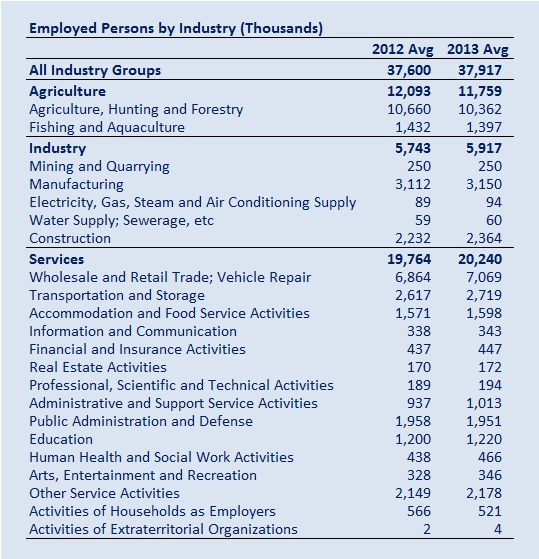Filipinos want to work but the jobs aren’t there. What’s to be done?
This article is a bit of a diary. I’m writing as I discover things, so pardon me if there is a shift in direction here or there. . .
It seems to me that to develop a model for job growth in the Philippines, it would be wise to identify the industries that are job rich and under-performing, like tourism and agribusiness. Or we can look at products where manufacturing can establish the core business around which a huge framework of supporting industries can grow, like finance, construction, technology and trade. Take boat-building as an example.
The Philippine labor-cost advantage will fade as the nation becomes richer and more competitive. Industries such as call centers or electronics manufacturing will become vulnerable in a rising, richer, competitive nation.
How can we find more jobs?
It struck me that a sizable industry in the Philippines that is not recognized as an industry is “entertainment”. It is one of those jazzy, soft industries of color and show, not unlike tourism I suppose. I am always impressed by the number and quality of entertainment shows produced professionally pretty much on the fly, or the music competitions or beauty contests or arts or movies (who is the modern Fernando Poe character, I wonder). I also categorize magazines and newspapers as “entertainment” because there is not much in-depth news there. And sports, of course, led by Representative Pacquiao.
So the question arose, cannot the entertainment business be leveraged better for global markets? To create a lot MORE jobs? Is it substantial enough as an industry?
I set out to do an official sizing of Philippine industries and it took a while to get oriented. Wikipedia did not offer much in the way of statistics but did define the following industries as particularly important in the Philippines:
- Agriculture
- Shipbuilding and repair
- Automotive
- Aerospace
- Electronics
- Mining and extraction
- Offshoring and outsourcing
I was surprised that the Philippines is the fourth largest ship-building nation in the world and that the work pool is drawn from the nation’s 60,000 certified welders.
Aerospace and Electronics involve primarily the production of parts for overseas companies.
Next, I went to NEDA, the National Economic and Development Authority. This agency is always perplexing to me. Such an important function, but NEDA produces so much detail that it buries synthesis and profound reasoning under mind-boggling words and charts. I can never see the forest for the number of trees NEDA’s publications keep throwing in my face.
Surprisingly, the National Development Plan does not have an industry focus other than featuring Agriculture and Fisheries Industry for special attention. How can you generate jobs without considering the condition of the various industries? Here is the link to the National Development Plan Results Matrix provided on NEDA’s web site. Lots of luck.
But I finally was able to find the statistics I wanted, and also learned the good news that a lot of Philippine statistical resources are being pulled together under the Philippine Statistics Authority. The employment statistics I was looking for are housed subordinate to the Statistics Authority at the Bureau of Labor and Employment. Here’s the relevant information:
The large employment industries and trends are as follows:
- Agriculture: 10.4 million jobs and shrinking.
- Retail/Wholesale Trade: 7.1 million jobs and growing.
- Manufacturing: 3.2 million jobs with little growth.
- Transportation: 2.2 million with some growth.
- Defense: 2.0 million and steady.
- Construction: 2.4 million and growing.
- Other Services: 2.2 million with some growth.
- Hotels/Restaurants: 1.6 million and some growth.
- Fishing: 1.4 million and shrinking.
- Education: 1.2 million and some growth.
Mining was surprisingly low to me, at only 250,000, and the “entertainment” industry logged in at a rather puny 346,000 (excluding newspapers but adding in some tourism attractions). None of the industries showed dynamic growth. Strongest growth areas are retail/wholesale trade and construction. They are cyclical, the former dependent on consumer buying tendencies, the latter on investment.
Clearly, an annual increase of 317,000 jobs on an employment base of 38 million jobs is not going to improve the job picture fast enough.
Furthermore, in a deeper, more vibrant economy, we’re likely to see an acceleration of the trends shown in the table, with agribusiness employment down due to more efficient farming, and jobs shifting to the packaging and selling of products.
Very clearly, my hypothesis that entertainment could be a jobs machine was proved highly unlikely. The base is small. It is just a highly visible industry without a lot of depth.
Trendy ideas like “medical tourism” (e.g.,foreign residents coming to Subic for low-cost medical care) are not likely to add much.
That leads to the question, and I convey it to readers, how does the Philippines generate more jobs?
My suggestions from past blogs include:
- Entice Japanese manufacturers out of China and to the Philippines
- Build a military manufacturing capacity: boats and missiles and other hardware
- End the cooperative framework for farming and replace it with competitive corporate agribusiness.
There are also new policy frameworks that could be deployed to support job growth:
- Pass a Fair Employment Law. Make sure there are career tracks available to get rid of hiring and promoting for favor. Build skills into the corporate sector. With that, more globally competitive enterprises will emerge, and more jobs.
- Pass anti-trust laws that create genuine competition rather than today’s “gamed” market that has banks basically colluding on interest rates rather than market forces driving them, and which allow the giant food packaging companies to set agricultural product prices to farmers very low, and other anti-competitive practices. More competition, more vibrant investment in technology and productivity, better efficiency, more jobs.
- Build a self-contained military-industrial complex so that every ship and missile, and every bullet fired in training, is made in the Philippines. And Kevlar helmets, too, thank you kindly Ms. Napoles. If Coors Beer could make porcelain based flack vests for American soldiers (they did; my mother made the porcelain parts), San Miguel can do the same.
It makes so little sense to me that we are paying American wage scale when we buy military ships when we could build them in the Philippines, pay less, and employ thousands. So I think if the Philippines is serious about defense, it will invest in it big time.
Your ideas?



No comments:
Post a Comment